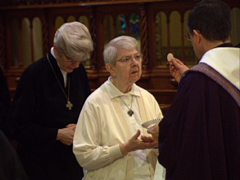Sometimes we liturgical commentators spend a little too much time on the ideal plane of the choir loft without getting the full congregational view of things.
In those times I attend Sunday Mass in the pews, I find it astonishing how much of the average worship experience is dominated by a role unmentioned in the GIRM: the ubiquitous usher.
The distractions available to ushers are legion. Before Mass, they can stand in the back of church chatting, or in the sanctuary doublechecking the sacristan’s work, or in the nave guiding people to seats they could easily find themselves.
During the collection they can say “thank you” to each person who puts something in the basket. Or they can swoop the basket under people who give through their bank, as a helpful reminder.
All of these things I have winessed, and I have also seen usher’s heroics as well. Ushers tend to be amazing with persons who need help, from pointing out the restroom to sitting folks in the wheelchair section to asking that Communion be brought to a person with mobility problems. There is no place medically better to collapse, except in a hospital, than at Sunday Mass, due to the instant and decisive activity of ushers.
On the other hand, ushers, in my opinion, belong nowhere near the Communion line. People know how to go to Communion, and ushers have several unfortunate effects on the experience. They are distracting, and sometimes casually so, engaging people at a very solemn moment. Communion becomes something everyone in the row does, in orderly lines, rather than those who are properly disposed.
Suppose this is the first Mass I’ve attended for 20 years, just dropping in, and I haven’t been to confession in 30 years. This would be an odd moment to go to Communion. And yet, there is a man with a badge, insisting that it is my turn. I’d better go.
Or suppose I ate a McBreakfast on the way to a 25 minute early morning quiet Mass. The fast is a rule, I’ll be more prudent next time–if I’m brave enough to disobey the usher.
Or just suppose I am praying deeply, and would like a minimum of input right at the moment. An usher once gave me a quite unnecessary verbal direction about venerating the cross on Good Friday, as I was trying to focus on the Lord in worship at this rare and holy moment. Why did we need an usher directing the veneration line?
Without in any way discounting the generous service of these fine people, in general I feel it’s a good idea to think about the way things have been done, even–or perhaps especially–if they have been done that way for many years.


